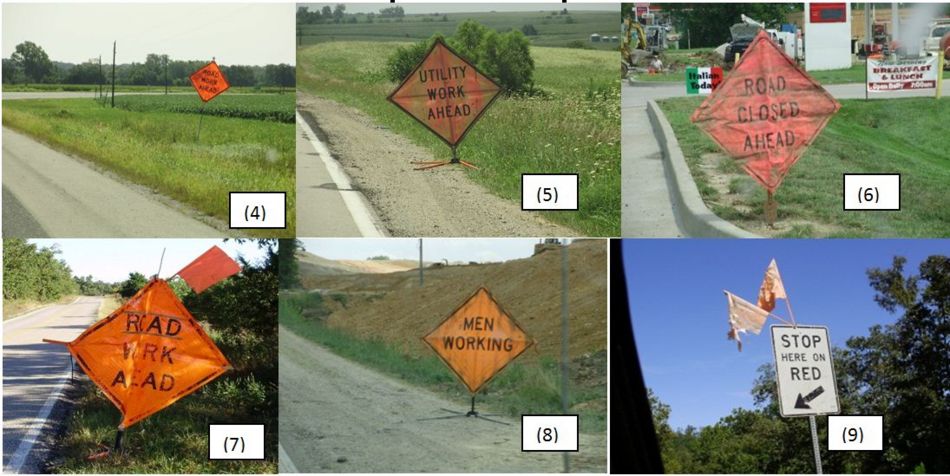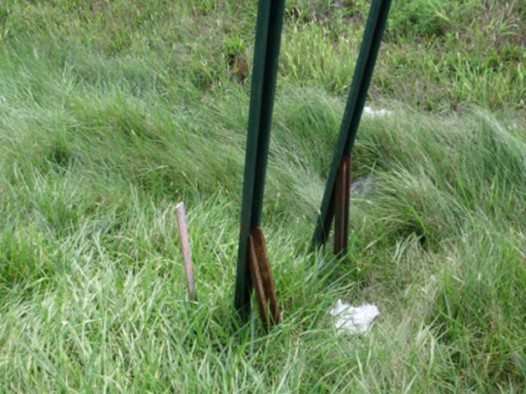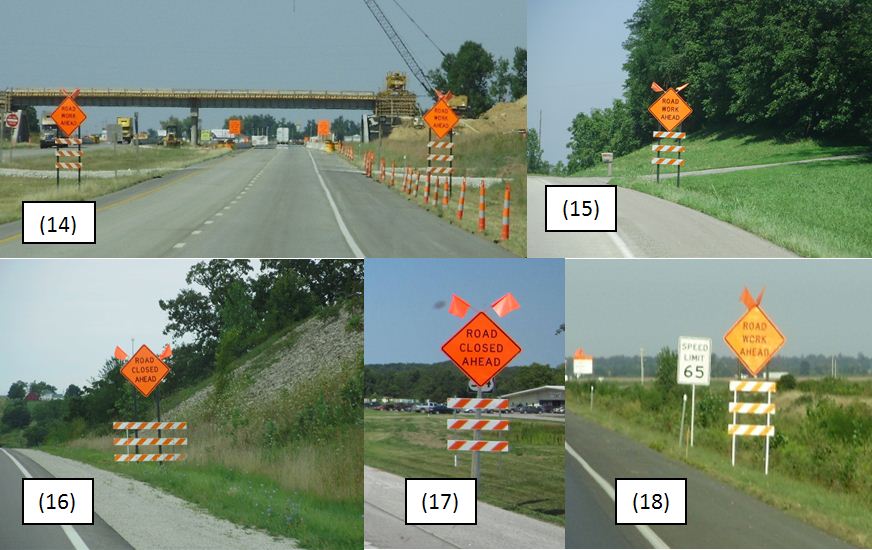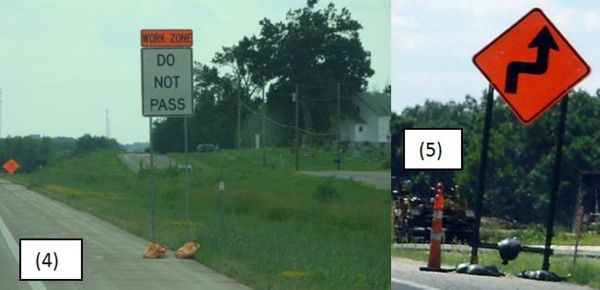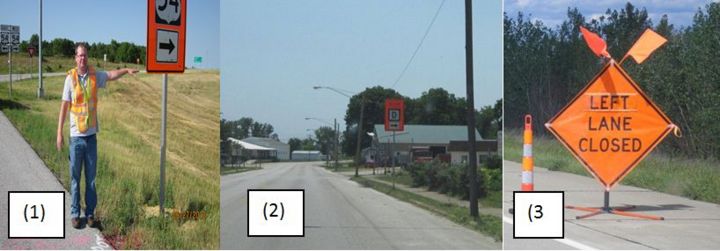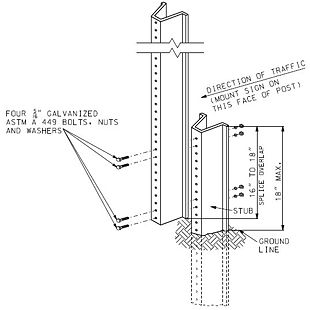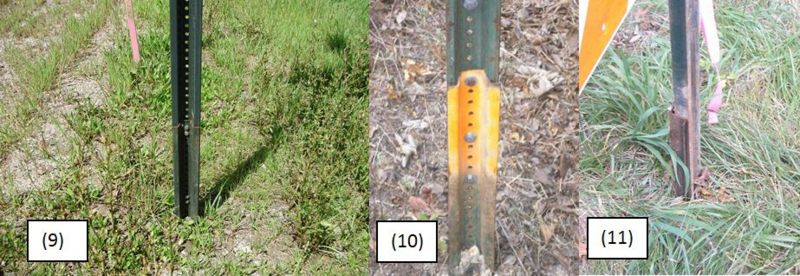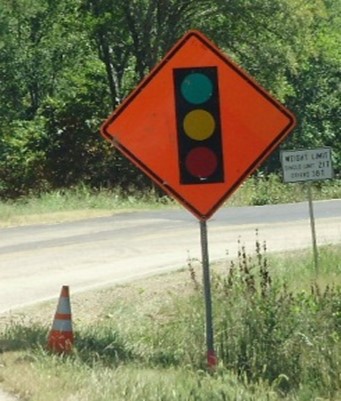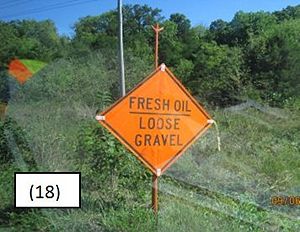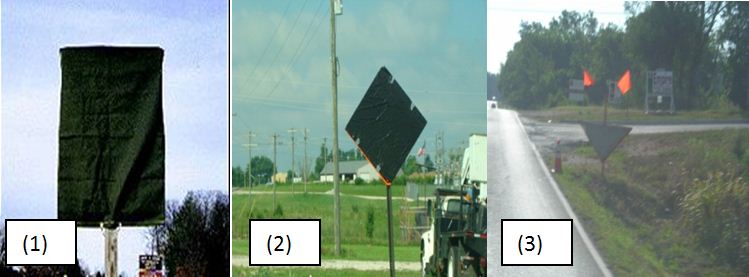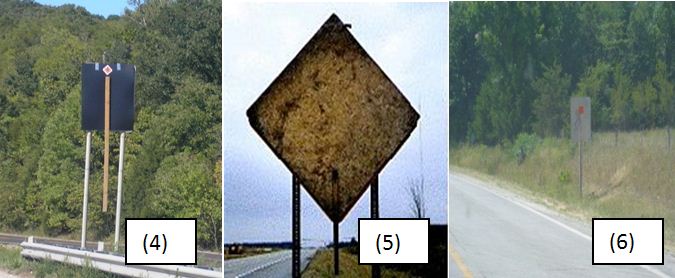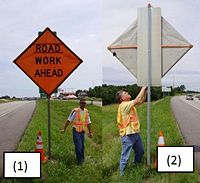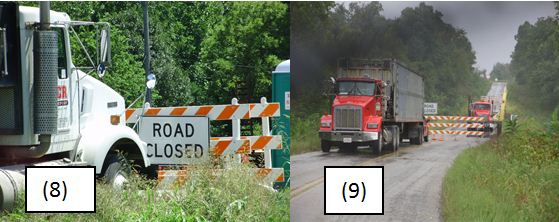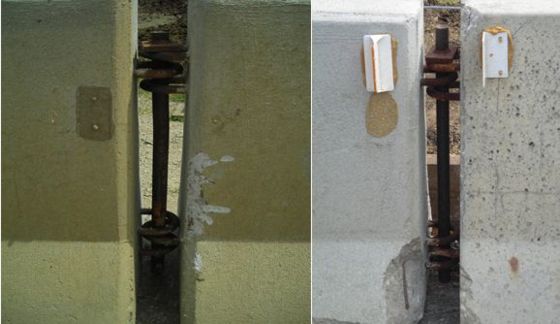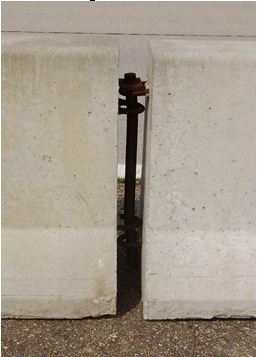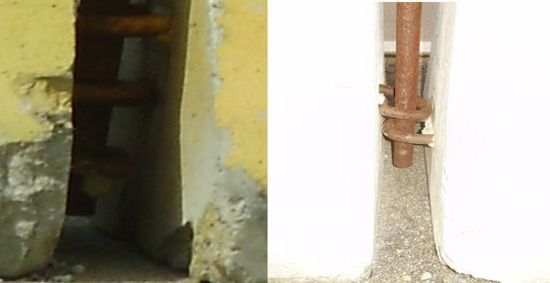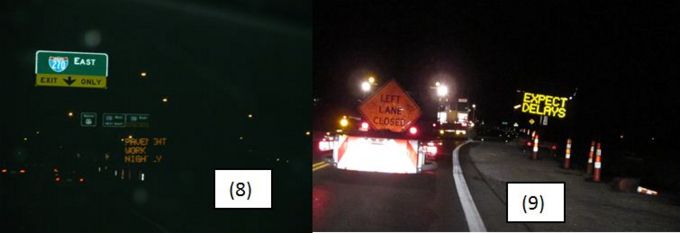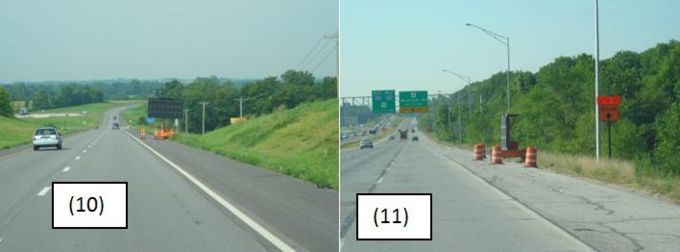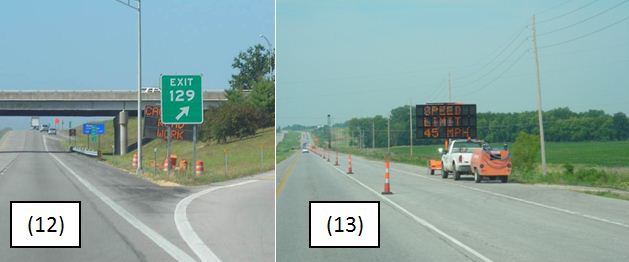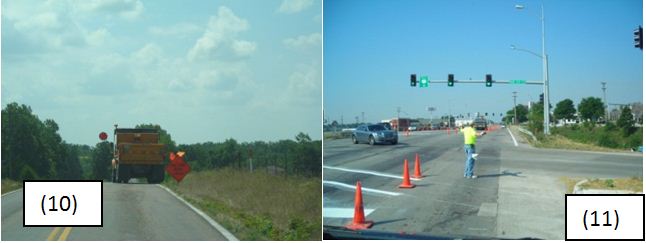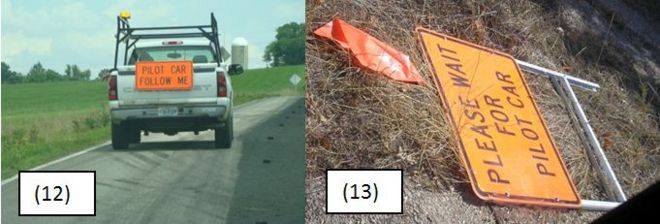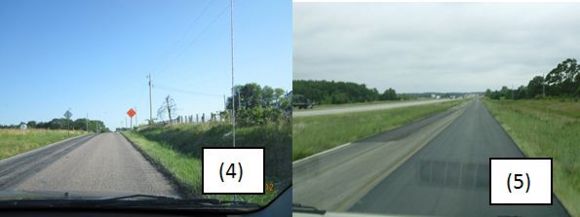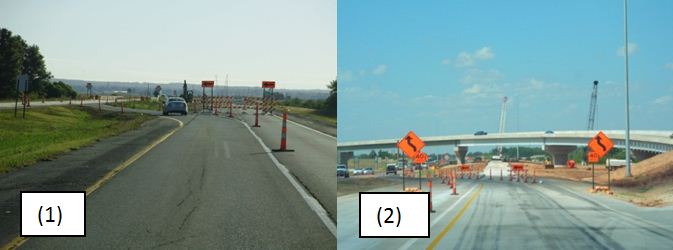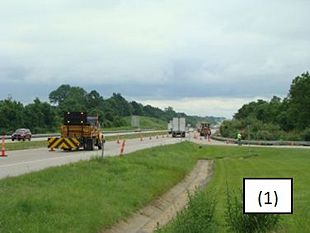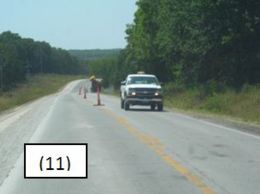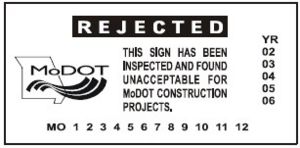Difference between revisions of "616.19 Quality Standards for Temporary Traffic Control Devices"
m (Per Traffic, updated entire article to provide superior guidance) |
|||
| Line 309: | Line 309: | ||
|colspan="2" align="center"|[[image:616.19.2.6 4.jpg|center|950px]] | |colspan="2" align="center"|[[image:616.19.2.6 4.jpg|center|950px]] | ||
|- | |- | ||
| − | |width=" | + | |width="200" align="center"|'''Acceptable Example''' ||width="720" align="center"|'''Unacceptable Examples''' |
|} | |} | ||
| Line 318: | Line 318: | ||
|colspan="2" align="center"|[[image:616.19.2.6 8.jpg|center|800px]] | |colspan="2" align="center"|[[image:616.19.2.6 8.jpg|center|800px]] | ||
|- | |- | ||
| − | |width=" | + | |width="230" align="center"|'''Height Transition''' ||width="560" align="center"|'''Proprietary Crash Cushions''' |
|} | |} | ||
Revision as of 12:35, 1 July 2013
Temporary traffic control devices (TTCDs) are an essential part of highway work zones. Even though workers and flaggers are not devices, they will be described in this article because of their relationship with work zones. TTCDs warn motorists of hazards, advise them of the proper path through the work area, delineate areas where they may not operate and separate motorists from workers and opposing traffic.
| Inspection Worksheet |
| Temporary Traffic Control Inspection Worksheet |
There are many factors that ensure the success of these functions; the placement and condition of each TTCD are two important factors. TTCDs that are worn, damaged or improperly installed will significantly lower the overall quality of a work zone. Clean, legible, properly installed TTCDs will command the respect of road users.
These quality standards are intended as a resource to determine if TTCDs are meeting current traffic needs in terms of legibility, visibility and other safety and mobility requirements for TTCDs (e.g., impact attenuators, truck-mounted attenuators, signs, channelizers, barricades, warning lights, changeable message signs, flashing arrow panels, work zone traffic signals, lighting units, temporary pavement marking, temporary traffic barrier, etc.) deployed on the state highway system. Effective application of these quality standards will benefit everyone that works in or navigates through work zones on the state highway system.
Contents
- 1 616.19.1 Quality Requirements
- 2 616.19.2 Quality Standards
- 2.1 616.19.2.1 General
- 2.2 616.19.2.2 Signs
- 2.2.1 616.19.2.2.1 Sign, Flag and AWRS Quality
- 2.2.2 616.19.2.2.2 Proper Sign Color
- 2.2.3 616.19.2.2.3 Information From the Signs
- 2.2.4 616.19.2.2.4 Ballasting of Signs
- 2.2.5 616.19.2.2.5 Additional Sign Examples
- 2.2.6 616.19.2.2.6 Sign Placement and Installation
- 2.2.7 616.19.2.2.7 Sign Coverings
- 2.2.8 616.19.2.2.8 Sign Innovations
- 2.3 616.19.2.3 Channelizing Devices
- 2.4 616.19.2.4 Barricades
- 2.5 616.19.2.5 Temporary Traffic Barriers
- 2.6 616.19.2.6 Impact Attenuators/Crash Cushions/End Treatments
- 2.7 616.19.2.7 Changeable Message Sign/Flashing Arrow Panels/Traffic Signals
- 2.8 616.19.2.8 Lighting
- 2.9 616.19.2.9 Flagging Operations and Worker Apparel
- 2.10 616.19.2.10 Paint/Tape/Pavement Markers
- 2.11 616.19.2.11 Tapers/Transition Areas/Lane Widths/Crossovers
- 2.12 616.19.2.12 Roadway Conditions/Temporary and Uneven Pavement/Unprotected Hazards
- 2.13 616.19.2.13 Entrance and Exit Ramps
- 2.14 616.19.2.14 Truck and Equipment Access
- 2.15 616.19.2.15 Traffic Management
- 2.16 616.19.2.16 Rejected Stickers
616.19.1 Quality Requirements
TTCDs shall be installed and maintained in an acceptable condition. Unless specified otherwise, this requirement does not mandate the use of new devices but it does necessitate the use of functional devices. Unacceptable devices shall be replaced or corrected in accordance with the contract documents or in the absence of a contract (e.g., permit projects) as directed by MoDOT’s representative.
When reviewing work zones, the MoDOT Temporary Traffic Control Inspection Worksheet is a valuable tool for determining the safety and mobility performance of all work zones including federal and state funded contract, state maintenance, and permit projects (as shown at the end of the article).
The MoDOT Temporary Traffic Control Inspection Worksheet rating system is based on the following letter grade system:
- A – Above and beyond the standards and specifications of the project.
- B – Meeting the standards and specifications of the project.
- C – A couple of deficiencies meeting the Category 3 severity level of Sec 616.
- D – Several deficiencies meeting the Category 3 severity level of Sec 616 or a couple of deficiencies meeting the Category 2 severity level of Sec 616.
- F - Several deficiencies meeting the Category 2 severity level of Sec 616 or one or more deficiencies meeting the Category 1 severity level of Sec 616.
Category severity levels are as follows:
Category 1 – Presents an immediate safety issue for the traveling public or workers and needs to be addressed immediately.
Category 2 – The situation doesn’t pose an immediate safety issue for either the public or the workers, but can impact the proper functioning of the work zone.
Category 3 – The situation doesn’t impact the functioning of the work zone but is more of a maintenance or aesthetic issue.
When inspecting a work zone and a Category 1 severity level is noted, remain at site until the appropriate personnel has been contacted and advised of the deficiency. For Categories 2 and 3, contact the appropriate personnel as soon as possible. The district Work Zone Coordinator is a valuable resource and the primary point of contact for questions and concerns.
Document all deficiencies on the worksheet along with any corrective action(s) taken and/or the time/date that appropriate personnel was contacted to initiate the corrective action(s).
The work zone should be re-inspected to ensure that all deficiencies have been corrected.
616.19.2 Quality Standards
616.19.2.1 General
All TTCDs shall be:
- In conformance with the requirements of the MUTCD and MoDOT Standards.
- Installed and maintained at locations and in orientations that maximize safety and minimize disruption to traffic flow.
- Aligned with the road user’s line of sight.
- Positioned in a manner not to obstruct other traffic control devices.
- Free of dents, holes, deformations, abrasions, tears, marks, stains, residues, fading or other deficiencies that adversely affects the operational performance including the crashworthiness of a device.
- Properly covered, turned, stowed, or removed when not in use.
- Visible during daytime and nighttime operations.
616.19.2.2 Signs
616.19.2.2.1 Sign, Flag and AWRS Quality
The signs and flags in Pictures 1, 2 and 3 are considered in good quality. For enhanced visibility a cone may be placed next to a sign. Picture 2 is an example of the proper placement of a FLAGGER sign in advanced of the hill vs. after the hill. In urban areas with barrier walls and narrow shoulders, a truncated sign may be used as shown in Picture 3.
NOTE: TTCDs may be highly visible during the day but may not be at night due to inadequate retroreflectivity. MoDOT and Contractor representatives should drive through the work zone at night to check nighttime visibility.
The above signs (4, 5, 6 and 7) are in unacceptable condition. Dirty or damaged signs should be cleaned, repaired, or replaced before being installed. When cleaning, follow manufacturer’s recommendations, so that the daytime and nighttime visibility of the sign is not adversely impacted. The MEN WORKING sign (8) should be replaced with worker symbol sign or WORKERS sign (WO-21-1 or 1a) to meet current standards Picture 9 shows unacceptable flags. Deteriorated flags should be replaced.
Signs 10 and 12 are examples of acceptable nighttime visibility and signs 11 and 13 are examples of unacceptable nighttime visibility. Proper storing, transporting and covering can lengthen the life of a sign. Rigid signs should be stored and transported vertically without rubbing the sign face.
Advance Warning Rail System (AWRS) is required on the first advance warning sign(Road/Bridge Work Ahead) on long-term stationary projects. The barricade stripes slope downward toward the roadway as shown above. Pictures 14 and 15 are examples of acceptable AWRS installations. When a Type 3 Barricade is used with a sign as shown Picture 16, the barricade should be located between 7 to 10 ft. from the sign (to be crashworthy). Either a 4 ft. or 8 ft. barricade may be used. A 4 ft. AWRS on single post is acceptable as shown in Picture 17 provided the sign post has been sized to meet the added weight and square footage of the AWRS. AWRS with vertical legs are acceptable if bolted to the sign post legs as shown in picture 18.
616.19.2.2.2 Proper Sign Color
Sign colors are reserved for specific applications. Orange is reserved for temporary traffic control, pink for incident management, yellow for warning, and red/black/white for regulatory signs. The UTILITY WORK AHEAD and the LANE CLOSED AHEAD signs in Pictures 2 and 3 should be orange not pink or yellow. The speed limit sign in picture 4 is correct color for a regulatory sign. The WORK ZONE plaque is required for speed limit signs within the work zone if it changes from the permanent posted speed limit. Fluorescent orange signs as shown on the right in Picture 1 are required for MoDOT contract and maintenance projects. Permit projects may use enginering grade sheeting as shown on the left side of Picture 1 provided they meet MUTCD requirements. Note: Using tape on a sign can detroy the retroreflectivity of the sign as shown in Picture 3.
616.19.2.2.3 Information From the Signs
Pictures 1 thru 3 are examples of TTCDs that are visually obstructed or providing conflicting information. The TTCD in Picture 1 should be moved upstream from the permanent curve warning sign with written documentation as to why the sign was moved. The advance warning sign in Picture 2 should be relocated upstream of the tree or the tree should be trimmed (if within MoDOT ROW) to provide the required visibility. Picture 3 shows detour signs that are providing two detour options for the same route. To reduce motorist confusion it is best to provide only one detour option.
| Unacceptable Examples | Acceptable Example |
The ROAD WORK NEXT XX MILES signs have whole numbers not decimals or part of a mile. In Picture 4, the ROAD WORK NEXT XX MILE sign may look like 31 miles instead of 3.1 depending on speed of the motorist. For ROAD CLOSED XX MILES AHEAD signs, partial miles, for example 0.5 (Picture 5) or ¼ miles may be used but standard practice is to round miles to a whole number of miles or within 1 mile or just state AHEAD.
616.19.2.2.4 Ballasting of Signs
| Acceptable Example | Unacceptable Examples |
For portable signs, ballasting should be limited to one sand bag height on the sign legs as shown in Picture 1. The use of channelizer rings as shown in Pictures 2 and 3 are unacceptable.
For skid mounted signs, ballasting should be limited to one sand bag height on the sign legs as shown in Pictures 4 and 5. Picture 5 shows an acceptable use of ballasting for a skid mounted sign. The crossbar (Picture 5) should be no higher than 12 in. (one sandbag over the crossbar is acceptable).
Picture 6 shows a large mound of sandbags, which if hit could present a ramping situation for vehicles. Picture 7 has two sandbags on the crossbar which is unacceptable because of two different sign posts and two sandbags on the cross rail. In Picture 8 concrete is being used to ballast the sign, which is unacceptable.
616.19.2.2.5 Additional Sign Examples
Picture 1 shows a crossbrace above the 18 in. maximum height without sand bag or 12 in. maximum height with sandbag. Picture 2 shows a skid mounted sign stand laying on the ground attached to the sign post. The skid mount should be removed from the sign post and placed flat on the ground. As shown, this sign stand is not crashworthy. Picture 3 shows a sign laying in the street. This sign should be placed in a better location. Picture 4 shows two crashworthy products that have been placed closer than the recommended 7-10 ft. spacing. The 7-10 ft. spacing allows the signs to act independently of each other to meet crashworthy criteria.
Picture 5 is an example of a STOP sign not having a full face visible to the traveling public. The sign in Picture 6 is leaning and should be straighten to be perpendicular. When stubs are not driven deep enough into the ground a sign may lean or fall after a period of time. The sign in Picture 7 could be moved upstream or downstream to achieve a more perpendicular position. Be sure to document the location change, such as, “After reviewing the sign in the orginal position, the sign was moved 100 ft. upstream to be more level”. There are times due to terrain that a sign may not be completely level, but every effort should be made to install signs as close to perpendicular as possible.
Sign placement in urban areas can impede pedestrian travel as shown in Picture 8. Accommodations should be made for all modes of travel including pedestrians and bicycists. The sign post in Picture 9 should have only one sign, but a speed advisory plaque is allowed as shown in Std. Plan 616.10. A permanently posted SPEED LIMIT sign, as shown in Picture 10, should not be removed. If the posted speed limit is lowered, the proper procedure is to cover the sign as described in 616.19.2.2.7 Sign Coverings. Since the posted speed limit is laying down and the work zone speed limit was not in place, by state law the speed limit for this road’s functional classification could be higher than the posted speed limit. Placing the permanent sign on the ground could also reduce the life of the sign and/or void the manufacturer’s warranty.
| Unacceptable Examples | Acceptable Example |
Picture 11 shows an example of two work zones placed inside each other. Proper coordination should be of highest importance when work zones overlap each other. Picture 12 shows the signal head upside down. Picture 13 shows a new detour sign design on the right.
616.19.2.2.6 Sign Placement and Installation
Sign Height:
The post mounted sign shown in Picture 1 is mounted 5 ft. high from the edge of the roadway to the bottom of the sign as required for a rural location. For uban locations, post mounted signs should be 7 ft. as shown in Picture 2. For short term projects temporary signs, as shown in Picture 3, may have a minimum height of one foot. Additional information on sign installation and heights see Std. Plan 616.10.
| Acceptable Example | Unacceptable Examples |
When used, speed limit (regulatory) signs shall be installed at a 5 ft. (rural area) or a 7 ft. (urban area) mounting height as shown in Picture 4. Information on themounting height of the signs is located in Std. Plan 616.10. The mounting heights of the signs in Pictures 5 and 6 are not compliant with MoDOT/MUTCD standards. After December 2013, the work zone plaque will be 2 ft. high as shown in 616.6.12 Work Zone and Higher Fines Signs and Plaques (MUTCD 6F.12).
Lateral Sign Location: Sign locations should be located 6-12 ft. from the edge of the paved travel lane or shoulder as shown in Std. Plan 616.10. Due to terrain slopes, curves, shoulder widths, duration of projects, signs may deviate from recommended placement. Before installing signs, the project site should be reviewed to agree on the best location for signs.
Post Installations:
The complete U-channel Post details are located in Std. Plan 903.03 on Sheet 3.
| Acceptable Example | Unacceptable Examples |
Picture 9 is an example of a correct U-channel post splice, which shows the four bolts in the proper location, correct stub height and splice overlap. Note: The bolts can be installed in either direction. The stub height and splice overlap in Picture 10 is correct, but the 4-bolts are not in the proper locations. Picture 11 shows inadequate stub height and overlap and the sign post is not on the correct side of the stub. Missouri One-Call should always be notified prior to installing any sign post into the ground.
The installations in Pictures 12-14 are unacceptable. Picture 12 shows an installation of only 1 bolt per sign post leg. Picture 13 shows an installation of one post mounted leg and one skid mounted leg. Picture 14 shows two splices when only one splice is allowed.
Perforated Square Steel Tube Post (PSST) details are located in Std. Plan 903.03 on Sheet 3.
| Acceptable Examples | Unacceptable Example |
Pictures 15 and 16 shows proper installation of a PSST post. The PSST post does not have to use the corner bolt but can be bolted either with one or two straight bolts. However the corner bolt minimizes movement of the post within the tubes. Picture 17 shows a stub higher than the 2 in. maximum and the bolt should be bolted through the two posts. Missouri One-Call should always be notified prior to installing any sign post into the ground.
Picture 18 shows a crashworthy self-driving sign stand. Missouri One-Call should always be notified prior to installing any sign post into the ground.
616.19.2.2.7 Sign Coverings
Pictures 1 thru 3 show examples of signs properly covered by plastic sign cover, plastic taped securely to the sign without direct contact with the sign face and a roll-up sign folded down. Materials used should not allow the sign face to “bleed through” during daytime or nighttime use. Pictures 1 and 2 adequately cover the face of the sign.
Pictures 4 thru 6 are examples of acceptable materials to cover signs. Materials range from rubber that is used for mud flaps, lightweight plywood, or a matching sign cover. The sign covers should be adequately secured to the host sign assembly and sized to match the sign to completely cover the face. The cover should be constructed with non-metallic handles and spacers to keep the sign covers from damaging the sign face.
The sign cover in Picture 7 is not securely fastened and does not have a wooden handle. Picture 8 shows the sign cover not matching the shape of the host sign, which could provide conflicting information to motorists. Picture 9 shows duct tape covering part of the sign wording, which can damage the sign retroreflectivity. Picture 10 shows an example of unacceptable use of plastic taped to the sign. The plastic is coming off and the sign message can be read. The plastic is so thin that the words can be seen through the plastic.
616.19.2.2.8 Sign Innovations
Pictures 1 and 2 are examples of an innovative solution to use roll-up signs on the emergency reference markers for short duration work. Remember modifications to TTCDs may cause crashworthy concerns, requiring study and/or crash testing. Always check first before installing.
616.19.2.3 Channelizing Devices
Trim-line channelizers shown in Pictures 1 and 2 are the most commonly used work zone channelizer. Picture 3 shows channelizers with sequential lights on a nighttime interstate project. Warning lights on all channelizers, except cones, may be used as provided in the EPG and the Standard Plans. Picture 4 shows a drum-like channelizer. Trim-line and drum-like channelizers are commonly ballasted with weights called “rings”, which prevent the channelizers from being blown over by vehicles. Stacking of ballasts may be considered provided that it meets manufacturer’s recommendations for crashworthiness.
The direction indicator barricade (DIB) in Picture 5 are commonly used in the merge tapers, but the DIBs in Picture 6 with the panels on the drum-like channelizer are also acceptable. Picture 7 shows DIBs during nighttime work zone.
Picture 8 shows tubular markers separating opposing traffic. Picture 9 shows 28 in. cones being used for daytime projects on a minor roadway. Contract and maintenance operations are allowed to use the 28 in. cones on minor roadways and during daytime hours. Permit operations are allowed to use cones based on MUTCD standards. Picture 10 shows trim-line channelizers that may have limited nighttime visibility. Picture 11 shows a damaged trim-line that is in unacceptable condition.
616.19.2.4 Barricades
Picture 1 shows the proper placement of Type 3 barricades on a full roadway closure. The barricade installation also provides an adequate buffer space to the work area. At some locations, barricades have to be located at the bridge ends or work area due to side roads. Picture 2 shows equipment behind the barricades with as much buffer as could be provided due to an entrance located just upstream of the barricades.
Picture 3 shows a barricade installation located after the private entrance and before the bridge end. Notice how close the equipment is to the barricade, which creates a potential safety issue for workers and motorists should a vehicle crash through the barricade. Sites should be reviewed for the best location to store equipment/materials within the work area. For this example, the opposite end of the bridge had ample room to store equipment and worker vehicles. Picture 4 shows acceptable sheeting quality for nighttime use but notice the left barricade stripes are angling to the left instead of to the right. On full roadway closure, the stripes should slope into the Road Closed sign as shown in Pictures 1 and 2. Warning lights on barricades are optional as noted in the EPG and Standard Plans.
Picture 5 shows Road Closed barricades that were moved to let vehicles into the work area. If there is no constant delivery of material, the barricades should be opened and re-closed when the work vehicles enter or leave the work zone. Picture 6 shows haul trucks entering a work zone, but left the barricades to the side. This could allow the traveling public to follow. Picture 7 show the barricades staggered to allow haul trucks in and out of the work zone and the hauling was constant (one truck every 5 to 10 minutes). This was allowed by the inspector of the project, but once the hauling was completed the road was closed with the barricades as shown in Pctures 1 and 2. The ability to stagger the barricades for hauling purposes should be authorized by the inspector on construction projects or superintendent on maintenance operations.
Pictures 8 and 9 show trucks parked in front of barricades. Note: Equipment or vehicles should not be parked in front of barricades they should be moved to an appropriate location (i.e., behind the barricades).
| Acceptable Examples | Unacceptable Example |
Picture 10 shows a staggered closure which allows the traveling public to decide if they want to go down the road before they get to the full closure. The staggered closure in Picture 11 allows any traffic to turn around at the last entrance (lower right) before the full closure. One barricade and ROAD CLOSED signs as shown in Picture 12 can be used to inform the traveling public of road closures, which when used should be located on the shoulder. The barricade in Picture 13 is directing the traveling public in the opposite lane and not directing them back into the proper lane of travel with another barricade in the opposite lane. A single Road Closed XX Miles Ahead sign is allowed without barricades. Note: A full barricade closure is required at the work area.
The ballasting in Pictures 14 thru 17 are unacceptable applications. Tires should not be used as ballast. Sandbags are allowed as long as they are not stacked on each other (i.e., one bag level high to meet crashworthiness). Picture 17 shows old barrel rings around the legs of the barricades. If rings are used, only one is allowed per leg. As shown in Pictures 14 thru 16, the signs may be placed behind the Type III barricades. To be crashworthy, the sign and barricade should be separated by a distance of 7 to 10 ft. from each other so each device can act independently if struck by a vehicle.
The road closures in Pictures 18 thru 20 are unacceptable installations, the Type 3 barricades should have covered the full roadway width to meet the requirements for a full road closure. The sheeting on the barricades in Picture 20 is unacceptable due to the damaged sheeting on the rails.
616.19.2.5 Temporary Traffic Barriers
Pictures 1 thru 3 are acceptable installations of temporary traffic barriers (TTBs). Picture 1 shows a TTB shielding motorists from an edge drop-off and the workers from the vehicles. The TTB in Picture 1 was installed with tie-down straps which prevents tipping of the barrier at a drop-off edge. Stockpiled materials or equipment should not be placed within the 3 ft. buffer area behind a tie-down TTB. In Picture 1, the work side of the barrier is free of stockpile material or inactive equipment. The clearance (buffer) behind the TTB will change depending on the different types of TTBs and/or anchoring systems being used. The clearance area is needed to not impede the deflection of the TTB should it be impacted by a vehicle. Picture 2 shows diverting traffic around a bridge project. Picture 3 shows a TTB separating head-to-head traffic in an urban setting. For selecting proper TTB types on projects, proper installation of TTB and location of TTB, review EPG 617 Traffic Barrier, Std. Plans. 617.20 and 619.10.
2 and 3 Loop Type F Connections. Proper connections: For all TTB types, proper connections are essential to prevent separations of the TTBs when hit by an errant vehicle. Predominately, MoDOT uses the 3-loop Type F barriers on projects. MoDOT allows the use of the 2-loop Type F barrier until it is rejected based on Sec 1064. The 2-loop and 3-loop Type F barriers can be used together, but they must be connected with a connection rod and a bottom washer/retainer bolt and nut. The following examples will show proper connections of the barriers.
Proper connections: Two examples of proper connections of two 3-loop Type F barriers without bottom washer and retainer bolt and nut. The 3-loop connections provide adequate friction so the connection rod will not come out on impact.
Improper Connection: One 3-loop Type F barrier was turned 180 degrees and the two ends have four loops on top and two loops on the bottom. Care must be taken when installing barrier for proper orientation and loop connections.
When installing two 2-loop barriers or one 3-loop barrier and one 2-loop barrier, the connection rod shall have a bottom washer and retainer bolt and nut.
| Acceptable Example | Unacceptable Example |
Proper Connection: The left picture shows the bottom washer with retainer bolt and nut. Improper Connection: The right picture does not have a washer or retainer bolt.
616.19.2.6 Impact Attenuators/Crash Cushions/End Treatments
Exposed temporary concrete traffic barrier ends are treated by one of the following methods: Barrier Flare, Barrier Height Transitions, Crash Cushions (Sand Barrel Array and Proprietary Crash Cushion). Additional information is located in EPG 617.1.3 Temporary Concrete Traffic Barrier End Treatments and EPG 612 Impact Attenuators.
Picture 1 shows an acceptable installation of a sand filled impact attenuator (SFIA), which can be found in Std. Plan 612.20 and EPG 612 Impact Attenuators. While SFIA are the most common attenuators used, crashworthy end terminals are also available as described in EPG 606.1.3.2 Approved Crashworthy End Terminals. The Type 1 object marker in Picture 2 is unacceptable due to the damaged sign sheeting. Picture 3 shows SFIA barrels/modules in a line from the temporary TTB viewpoint. To be crashworthy, the SFIA barrels/modules must have the proper number and meet spacing requirements. The sand should always be kept dry. If water gets into the barrel it can adversely affect the crashworthiness of the device.
| Acceptable Example | Unacceptable Examples |
The sand filled impact attenuators (SFIA) barrels/modules in Picture 4 is an acceptable installation, but SFIA barrels/modules in Picture 5 are unacceptable because they are located too close to the TTB. SFIA should be placed a minimum of 24 in. from the end of the blunt end of TTB, guard rail, etc. Parking vehicles or equipment as shown in Picture 6 is also unacceptable since the vehicles are blocking a crashworthy product. Picture 7 shows a cluttered SFIA installation with plastic material and barrel channelizers. Note the porta-potty and equipment is located in close proximity of the SFIA . The porta-potty and equipment should be relocated outside of the clear zone area or behind the protective TTB.
| Height Transition | Proprietary Crash Cushions |
Picture 8 shows an acceptable installation of a traffic barrier height transition for locations with a posted speed limit of 35 mph or less prior to construction. Propreitary crash cushions as shown in Pictures 9 and 10 may be used when there is insufficient width to accommodate sand barrels.
Picture 11 shows a MoDOT style of truck or trailer mounted attenuator (TMA) delineation that is used by Maintenance forces. Picture 12 is the TMA delineation style that is acceptable for contract and permit projects. Additional information is located in EPG 612 Impact Attenuators.
616.19.2.7 Changeable Message Sign/Flashing Arrow Panels/Traffic Signals
Trailer mounted devices such as changeable message signs (CMS), flashing arrow panels (FAP), portable traffic signals and work area lighting are considered NCHRP 350 Category 4 (see below).
FHWA Explanation of Category IV (4) Category IV devices are devices which have proven to have significant value in the work zone by contributing to safer traffic operation though these devices may cause great harm to occupants of impacting vehicles. We believe that, as currently configured and deployed, these devices provide a net benefit to motorists. Substantial crash experience to date shows that crashes with these devices are rare. They have been identified by FHWA as portable, usually trailer-mounted, devices such as area lighting supports, flashing arrow panels, temporary traffic signals, and changeable message signs which are often used in or adjacent to the traveled way. The AASHTO / FHWA agreement calls for these devices to be studied and an implementation date announced by October 1, 2000. We would not expect to identify any new category IV devices unless they have a proven substantial operational benefit.
Picture 1 shows the correct flashing arrow panel (FAP) display, all lights working and proper intensity. Picture 2 shows one lamp out in the arrow head which is unacceptable. Picture 3 shows a truck blocking a FAP which is unacceptable. Below are items that would make the FAP installation unacceptable.
- More than one lamp, of those to be energized, out in stem and one or more lamps out in the arrow head(s) when in the arrow (single- or double-headed) and one or more lamps out when in the caution (four corners) modes.
- Not appropriately dimmed at night
The CMS messages in Pictures 1, 2 and 3 are acceptable. The messages provide information that static signs can not provide to the traveling public. The CMS are placed further upstream of the work zone or at strategic locations to provide information of the upcoming work zone to the traveling public. The channelizer placement in Picture 1, 2 and 3 shows the correct number of channelizers (5) and the correct placement (approximate 100 ft. taper). Channelizers are not required if the CMS is more than 15 ft. from edge of shoulder (edge of roadway if there is no shoulder), beyond ditch line, or behind curb or physical TTB (see Std. Plan 616.10 for further details). Picture 4 shows a Dynamic Message Sign (DMS) providing information of a work zone.
Messages on CMS boards should consist of no more than two phases and each phase should consist of no more than three lines of text. The maximum line of text should be no more than 8 characters.
Pictures 5, 6 and 7 are examples of CMS that are unacceptable due to the lights being either too dim or out, as they are not providing a clear and concise message to the traveling public.
Pictures 8 and 9 show active CMS in nighttime operations. Picture 8, message is too dim and not visible. Picture 9, message is too bright and creates glare. The CMS should be appropriately dimmed so the lights are not too bright for the traveling public.
Picture 10 shows a CMS where the lights are out or turned off. If the lights are not working, the CMS is unacceptable. If the CMS is not being used it should be turned off and rotated away from traffice as shown in Picture 11 or removed from the project. If the CMS is used when lane drops are used every day to 3-4 days then rotating the sign would be appropriate. If the CMS will not be needed for a week or more, then removal may be appropriate until it is needed again. Note: The taper length should be 100 ft. long with five channelizers.
Picture 12 shows a permanent sign blocking the CMS. In Picture 13, the truck should not be placed in front of the CMS board. For Picture 13, the speed limit message is just a reminder of the speed limit. A temporary sign should be used instead and the CMS removed. Actual enforcement of the speed limit requires a regulatory sign.
616.19.2.8 Lighting
Lighting consists of three types: Fleet, Work Area, and Overhead. The required fleet lights on construction-related vehicles and equipment is normally amber lights that are visible from 360 degrees and activated in the work zone, except on contract haul trucks. Fleet lights shall be used both daytime and nighttime. Work area lighting is located in areas where construction equipment and labor are active at night and provides a minimum intensity of 5 foot-candles. Overhead lighting shall be provided for flaggers, portable traffic signals, and other specified locations and provides a minimum intensity of 0.6 foot-candles at night.
| Acceptable Example | Unacceptable Example |
The balloon lights in Picture 1 correctly show the lights being diffused down toward the ground and away from the traveling public to prevent glare. A multiple light trailer is shown in Picture 2; the lights should be directed toward the ground and away from the traveling public.
616.19.2.9 Flagging Operations and Worker Apparel
616.19.2.9.1 Worker Apparel
MoDOT Personnel: The proper apparel for working and flagging situations is located in the following sections of the Risk and Benefits Management Manual:
- • Section 100 Head and Eye/Face Protection Policy
- • Section 105 Safety Footwear Policy
- • Section 106 Class II and III Safety Apparel
- • Section 107 Prescription Safety Eyewear
Contractor and Permit Personnel: The proper apparel for working and flagging situations is located in the following sections and articles:
- • Specification Section 616 Temporary Traffic Control
- • EPG 616.18 Construction Inspection Guidelines for 616
- • Contractor Safety Plan
Pictures 1 and 2 show the required MoDOT ANSI/ISEA Class 2 shirt or vest. Picture 3 shows a Class 3 jacket. Picture 4 shows Class E pants. During daytime operations, MoDOT personnel shall wear a minimum of Class 2 safety vest or shirt. During nighttime operations, MoDOT personnel shall wear a minimum of Class 3 safety apparel (Class 2 or 3 top and Class E pants). Pictures 1 and 3 show the required head, eye, and foot wear.
Contractor and Permit personnel must meet the minimum standards set forth within ANSI/IESA, MUTCD, and MoDOT specifications.
616.19.2.9.2 Flagging Operations
Picture 1 shows the flagger on the right side of the road stopping traffic and maintaining good eye contact with the traveling public. Once the flagger stops the first vehicle, the flagger proceeds to the middle of road where he is visible oncoming traffic as shown in Picture 2. The flagger should be aware of his/her surroundings. When it is time to release the vehicles (Picture 3), the flagger will return to the edge of the roadway or the shoulder and provide direction to the traveling public. Flaggers should be located at least 100 ft. from any equipment or vehicles and should have an escape route.
The flagger in Picture 4 does not have an escape route due to his location to the truck. The STOP/SLOW paddle should not be in a channelizer, but move with the person flagging the operation. The public should be separated from the work areas. The flagger in Picture 5 is not fully in control of his location and has no escape route. Picture 6 shows a flagger without an escape route and not following proper procedures.
Flaggers should stay at their station until either relieved or can be safely transferred to another location, the flagger should not have their back turned to oncoming traffic (picture 7). Picture 8 has too many vehicles around the flagger, he is located on the left of the dump truck. A flagger should not be located in the middle of the sign package but down stream of the flagger symbol sign (Picture 9).
Picture 10 shows a flagger directing traffic from a vehicle. Picture 11 shows a flagger directing traffic with hand signals, only law enforcment personnel is allowed to use hand signals to direct traffic. For intersections, additonal flaggers with STOP/SLOW paddles may be needed if law enforcement is not available.
The pilot vehicle is an effective option that can be used to guide motorists safely through work zones. The pilot vehicle driver should be familiar with the project and should control vehicle speeds through the project. Picture 12 shows a pilot vehicle with the appropriate sign on the rear of the vehicle which is highly visible to the traveling public. The PLEASE WAIT FOR PILOT CAR sign (Picture 13) should be used at state intersections and may be used on other routes as directed by the engineer. The sign should be removed or laid down when it is no longer applicable. Note: Flags are optional on these signs.
Pictures 14 thru 16 are examples of portable traffic signals, automated flagger assistance devices, and portable signal flagging devices.
616.19.2.10 Paint/Tape/Pavement Markers
Guidelines for pavement marking are located in EPG 620 Pavement Marking, Sec. 620 and Std. Plans. 620.00 and 620.10. Pictures 1, 2 and 3 are examples of temporary pavement marking (TPM) meeting specifications and standards. Picture 1 shows TPM for center line and edge lines. Picture 2 show TPM for a roadway with only a center line stripe. Picture 3 shows a solid line to keep traffic in the designated lanes.
The roadway in Picture 4 should have temporary center line pavement markers or stripes. Picture 5 shows a project using half of the permanent center line stripe as the pavement marking and not place temporary pavement marking until the other lane is overlaid, which is unacceptable. Several concerns were noticed: the overlay covered long stretches of center line stripe especially around curves, material tracking from the haul trucks covered partial or all of the stripes in many areas, and edge lines were not marked in this picture. Once any type of material covers the sheeting or beads of the temporary pavement markers, paint, or tape, the material loses it ability to retroreflect the vehicle’s light back to the driver.
Pavement marking installation and removal should be done carefully as not to misdirect the traveling public. The temporary pavement markings (Picture 6) were intended to move the traffic to a temporary shoulder lane. Note: The permanent center line should have been removed to avoid driver confusion. Picture 7 shows a right turn lane line partially removed, care should be given to completely remove all conflicting markings in accordance with the plans and specifications. In Picture 8 shows conflicting edge lines across the bridge.
Pictures 9 thru 12 are examples of pavement marking removal. Care should be taken not to scar the pavement when removing markings. There is an additional concern that scarring may misdirect motorist. Pictures 11 and 12 shows lane lines leading motorists into the the channelization. The dashed line should stop at a point when the two lanes are designated to end.
616.19.2.11 Tapers/Transition Areas/Lane Widths/Crossovers
| Acceptable Example | Unacceptable Example |
Picture 1 shows a proper crossover. The opposing lanes are completely closed with Type 3 barricades, unlike Picture 2 where the lanes are not completely closed with Type 3 barricades.
616.19.2.12 Roadway Conditions/Temporary and Uneven Pavement/Unprotected Hazards
Pictures 1 and 2 show materials being tracked onto the roadway by trucks and equipment accessing work area. The roadway should be cleaned as needed to protect the traveling public.
Picture 3 shows a bridge rail without a crashworthy end device (i.e. SFIA). Picture 4 shows a striper stopped in an open lane of traffic, being worked on. The culvert pipe in Picture 5 should not be placed in front of the barricade or any other location open to traffic. All three would be considered acceptable with the following modifications: sand barrels or temporary end treatment, move striper to a parking lot or use TMA if it cannot be moved, and move the culvert into a fully closed work area or outside the clear zone.
616.19.2.13 Entrance and Exit Ramps
Picture 1 shows an acceptable exit ramp closure.
616.19.2.14 Truck and Equipment Access
At this time there are no pictorial examples of truck and equipment access.
616.19.2.15 Traffic Management
Traffic Management is an inclusive term for the overall implementation and management of the work zone. Is the work zone providing a safe traveling experience for the public and a safe work area for the workers, providing the traveling public adequate and early information, and is it minimizing traffic delays.
To provide adequate traffic management many tools are available which includes but not inclusive to the following: signs, channelizing devices, changeable and dynamic message signs, intelligent transportation systems (ITS), detours, law enforcement, flagging operation, etc.
EPG 616.13 Work Zone Capacity, Queue and Travel Delay and EPG 616.14 Work Zone Safety and Mobility Policy have additional information for traffic management policies and tools.
Pictures 1 thru 3 are acceptable examples of traffic management. Picture 1 shows a long-term work zone that is providing a well defined merge taper with adequate striping and channelizers. Picture 2 shows a well marked crossover. The temporary work zone in Picture 3 shows proper delineation for head to head traffic while providing access to area businesses.
Pictures 4 and 5 are examples of providing the traveling public information of how wide the lanes are before entering the work area. The CMS message provides adequate information to allow the truckers to make a decision on the proper lane to use. Picture 6 is an example of height restriction for the traveling public. Note: Motor Carriers division should be notified of any weight, height and/or width restrictions that may occur in a work zone.
Pictures 7 thru 10 show examples of speed enforcement. Placement of law enforcement is at times difficult depending on the location of work zone. Picture 8 shows a law enforcement vehicle off the roadway but in a location that the traveling public can readily see the vehicle. Picture 9 has the law enforcement vehicle behind a protective vehicle. The law enforcement vehicle is not in the travel lane, but would be the first vehicle impacted by an errant traveler. The law officer should be down stream of the protective vehicle. Picture 10 shows a law officer stopping a motorist within a diverging area which may create conflicts with other motorists. If possible, stopping vehicles should be done outside the work zone area. Trying to stop vehicles within the work zone can cause excessive stopping, which can result in traffic back-ups.
Picture 11 shows a work zone vehicle driving in the opposite direction of travel. In general vehicles should be driven in the normal direction of traffic. If vehicles are driven in the oppostie direction this can result in motorist confusion especially at night. Note: All vehicles should be operated in accordance with the work zone speed limit.
616.19.2.16 Rejected Stickers
REJECTED stickers, with appropriate month and year designated, may be used by MoDOT personnel to identify unacceptable temporary traffic control devices. For barricades, channelizing devices and signs, the sticker should be located on the front-, left- and lower-most retroreflective area on the device. For other devices, the sticker should be located in a conspicuous place on the device.
Below are examples of rejection sticker locations:

